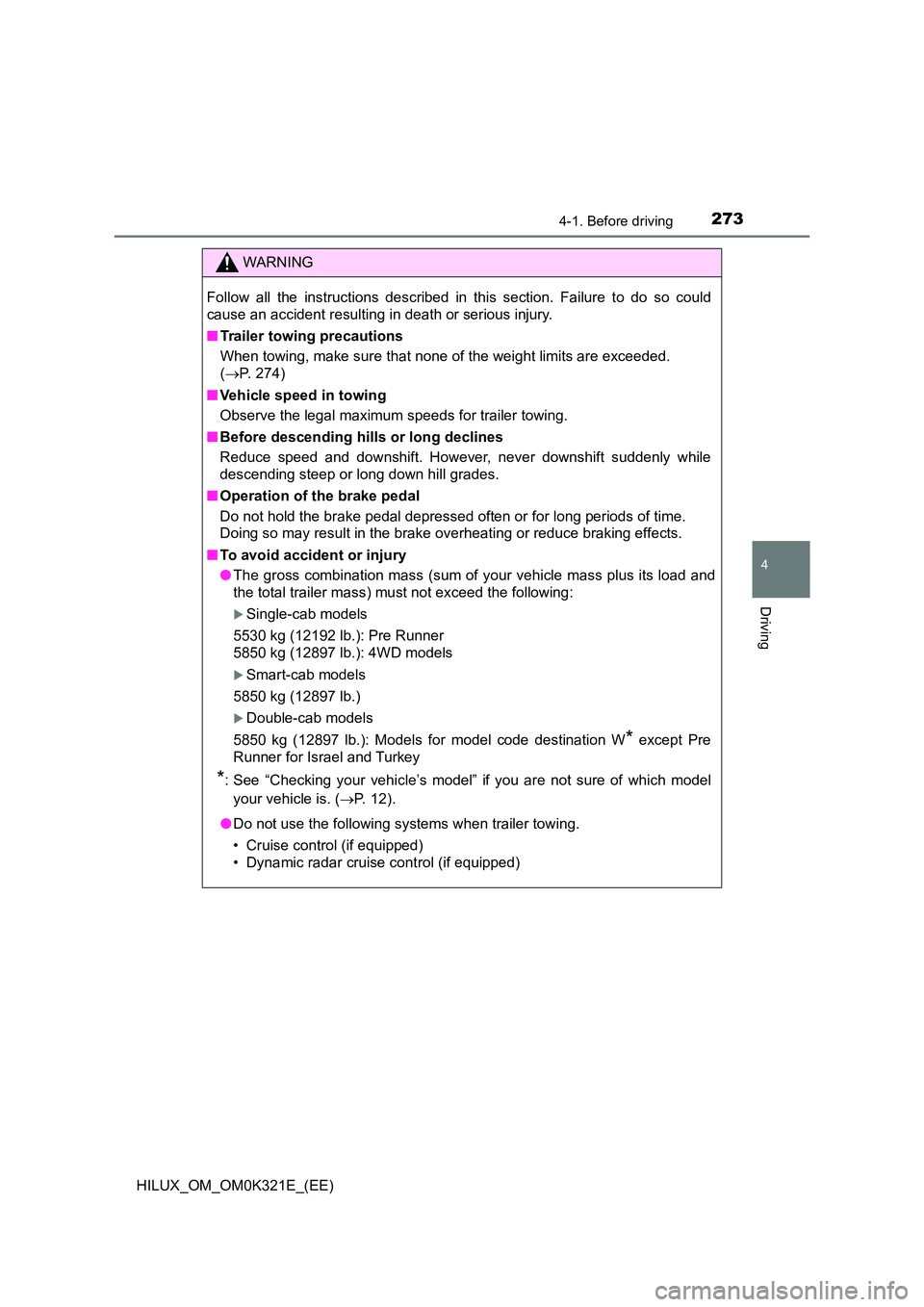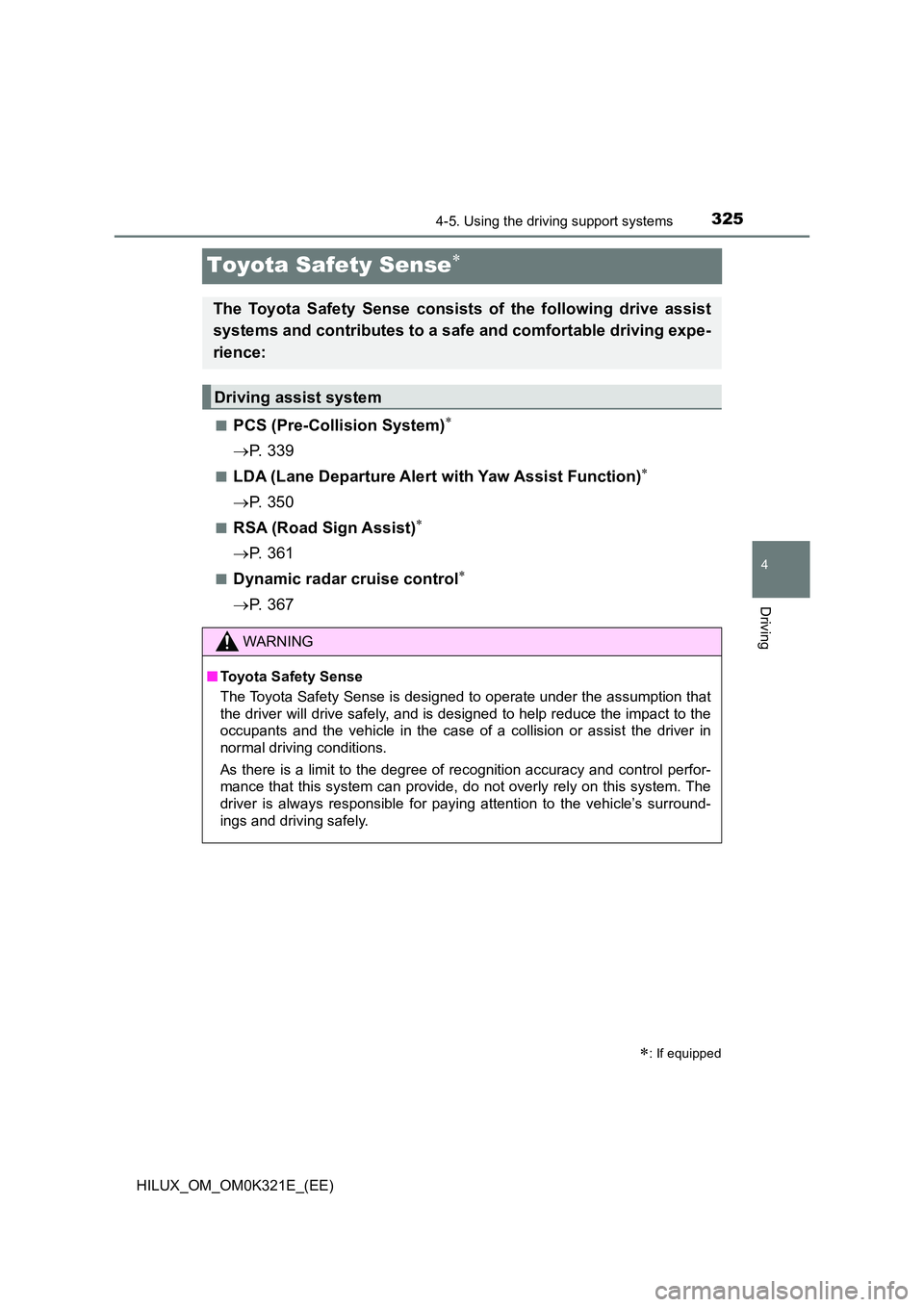Page 273 of 744

2734-1. Before driving
4
Driving
HILUX_OM_OM0K321E_(EE)
WARNING
Follow all the instructions described in this section. Failure to do so could
cause an accident resulting in death or serious injury.
■ Trailer towing precautions
When towing, make sure that none of the weight limits are exceeded.
( P. 2 7 4 )
■ Vehicle speed in towing
Observe the legal maximum speeds for trailer towing.
■ Before descending hills or long declines
Reduce speed and downshift. However, never downshift suddenly while
descending steep or long down hill grades.
■ Operation of the brake pedal
Do not hold the brake pedal depressed often or for long periods of time.
Doing so may result in the brake overheating or reduce braking effects.
■ To avoid accident or injury
● The gross combination mass (sum of your vehicle mass plus its load and
the total trailer mass) must not exceed the following:
Single-cab models
5530 kg (12192 lb.): Pre Runner
5850 kg (12897 lb.): 4WD models
Smart-cab models
5850 kg (12897 lb.)
Double-cab models
5850 kg (12897 lb.): Models for model code destination W* except Pre
Runner for Israel and Turkey
*: See “Checking your vehicle’s model” if you are not sure of which model
your vehicle is. ( P. 1 2 ) .
● Do not use the following systems when trailer towing.
• Cruise control (if equipped)
• Dynamic radar cruise control (if equipped)
Page 297 of 744

2974-2. Driving procedures
4
Driving
HILUX_OM_OM0K321E_(EE)
■S mode
When the shift range is 4 or lower, holding the shift lever toward “+” sets the
shift range to 6.
■ Downshifting restrictions warning buzzer
To help ensure safety and driving per formance, downshifting operation may
sometimes be restricted. In some circumstances, downshifting may not be
possible even when the shift lever is operated. (A buzzer will sound twice.)
■ Operation of the air conditioning system in Eco drive mode (vehicles
with automatic air conditioning system)
Eco drive mode controls the heating/cooling operations and fan speed of the
air conditioning system to enhance fuel efficiency ( P. 531). To improve air
conditioning performance, adjust the fan speed or turn off Eco drive mode.
■ Deactivation of the driving mode
● Eco drive mode will not be canceled until the “ECO MODE” switch is
pressed, even if the engine is turned off after driving in Eco drive mode.
● Power mode will be canceled if the engine is turned off after driving in power
mode.
■ When driving with cruise control or dynamic radar cruise control acti-
vated (if equipped)
Even when performing the following actions with the intent of enabling engine
braking, engine braking will not activate because cruise control or dynamic
radar cruise control will not be canceled.
● While driving in S mode, downshifting to 5 or 4. (P. 296)
● When switching the driving mode to power mode while driving in D.
( P. 295)
■ Shift lock system
The shift lock system is a system to prevent accidental operation of the shift
lever in starting.
The shift lever can be shifted from P only when the engine switch is in the
“ON” position (vehicles without smart entry & start system) or IGNITION ON
mode (vehicles with smart entry & start system) and the brake pedal is being
depressed.
Page 325 of 744

325
4
4-5. Using the driving support systems
Driving
HILUX_OM_OM0K321E_(EE)
Toyota Safety Sense
■PCS (Pre-Collision System)
P. 3 3 9
■LDA (Lane Departure Alert with Yaw Assist Function)
P. 3 5 0
■RSA (Road Sign Assist)
P. 3 6 1
■Dynamic radar cruise control
P. 3 6 7
: If equipped
The Toyota Safety Sense consists of the following drive assist
systems and contributes to a safe and comfortable driving expe-
rience:
Driving assist system
WARNING
■ Toyota Safety Sense
The Toyota Safety Sense is designed to operate under the assumption that
the driver will drive safely, and is designed to help reduce the impact to the
occupants and the vehicle in the case of a collision or assist the driver in
normal driving conditions.
As there is a limit to the degree of recognition accuracy and control perfor-
mance that this system can provide, do not overly rely on this system. The
driver is always responsible for paying attention to the vehicle’s surround-
ings and driving safely.
Page 326 of 744
3264-5. Using the driving support systems
HILUX_OM_OM0K321E_(EE)
Two types of sensors, located behind the front grille and windshield,
detect information necessary to operate the drive assist systems.
Radar sensor
Front camera
Sensors
1
2
Page 327 of 744

3274-5. Using the driving support systems
4
Driving
HILUX_OM_OM0K321E_(EE)
WARNING
■To avoid malfunction of the radar sensor
Observe the following precautions.
Otherwise, the radar sensor may not operate properly, possibly leading to
an accident resulting in death or serious injury.
● Keep the radar sensor and the grille cover clean at all times.
● Do not attach accessories, stickers (including transparent stickers) or
other items to the radar sensor, grille cover or surrounding area.
● Do not subject the radar sensor or its surrounding area to a strong impact.
If the radar sensor, front grille, or front bumper has been subjected to a
strong impact, have the vehicle inspected by any authorized Toyota
retailer or Toyota authorized repairer, or any reliable repairer.
● Do not disassemble the radar sensor.
● Do not modify or paint the radar sensor or grille cover.
● If the radar sensor, front grille, or front bumper needs to be removed and
installed, or replaced, contact any authorized Toyota retailer or Toyota
authorized repairer, or any reliable repairer.
Radar sensor
Grille cover
If the front of the radar sensor or the
front or back of the grille cover is dirty
or covered with water droplets, snow,
etc., clean it.
Clean the radar sensor and grille cover
with a soft cloth to avoid damaging
them.
1
2
Page 338 of 744
3384-5. Using the driving support systems
HILUX_OM_OM0K321E_(EE)
● In the following situations, if the situation has changed (or the vehicle has
been driven for some time) and the normal operating conditions are
detected, the message will disappear and the system will become opera-
tional.
If the message does not disappear, contact any authorized Toyota retailer
or Toyota authorized repairer, or any reliable repairer.
• When the temperature around the radar sensor is outside of the opera-
tional range, such as when the vehicle is in the sun or in an extremely
cold environment
• When the front camera cannot detect objects in front of the vehicle, such
as when driving in the dark, snow, or fog, or when bright lights are shining
into the front camera
Page 339 of 744
339
4
4-5. Using the driving support systems
Driving
HILUX_OM_OM0K321E_(EE)
PCS (Pre-Collision System)
The system can detect the following:
● Ve hi cl e s
● Bicyclists
● Pedestrians
: If equipped
The pre-collision system uses a radar sensor and front camera
to detect object ( P. 339) in front of the vehicle. When the sys-
tem determines that the possibility of a frontal collision with an
object is high, a warning operates to urge the driver to take eva-
sive action and the potential brake pressure is increased to help
the driver avoid the collision. If the system determines that the
possibility of a frontal collision with an object is extremely high,
the brakes are automatically applied to help avoid the collision
or help reduce the impact of the collision.
The pre-collision system can be disabled/enabled and the warning
timing can be changed. ( P. 343)
Detectable objects
Page 342 of 744

3424-5. Using the driving support systems
HILUX_OM_OM0K321E_(EE)
WARNING
■When to disable the pre-collision system
In the following situations, disable the system, as it may not operate prop-
erly, possibly leading to an accident resulting in death or serious injury:
● When the vehicle is being towed
● When your vehicle is towing another vehicle
● When transporting the vehicle via truck, boat, train or similar means of
transportation
● When the vehicle is raised on a lift with the engine running and the tires
are allowed to rotate freely
● When inspecting the vehicle using a drum tester such as a chassis
dynamometer or speedometer tester , or when using an on vehicle wheel
balancer
● When a strong impact is applied to the front bumper or front grille, due to
an accident or other reasons
● If the vehicle cannot be driven in a stable manner, such as when the vehi-
cle has been in an accident or is malfunctioning
● When the vehicle is driven in a sporty manner or off-road
● When the tires are not properly inflated
● When the tires are very worn
● When tires of a size other than specified are installed
● When tire chains are installed
● When a compact spare tire or an emergency tire puncture repair kit is used
● If equipment (snow plow, etc.) that may obstruct the radar sensor or front
camera is temporarily installed to the vehicle